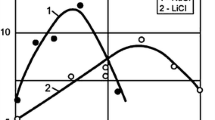Abstract
SOME time ago Molenaar and Aarts1 observed that the increase of the resistivity of copper, silver and aluminium wires, caused by a plastic deformation at liquid-air temperature, decreased on keeping the wires at room temperature. The recovery of the resistivity was not accompanied by a recovery of the mechanical properties. The stress–strain curve at liquid-air temperature was not changed by this temporary heating.
Similar content being viewed by others
References
Molenaar, J., and Aarts, W. H., Nature, 166, 690 (1950).
Seitz, F., Phys. Rev., 80, 239 (1950) and a paper to be published later.
Author information
Authors and Affiliations
Rights and permissions
About this article
Cite this article
DRUYVESTEYN, M., MANINTVELD, J. Change of Resistivity of Gold by Cold-working at Liquid-Air Temperature and its Recovery by Temporary Heating. Nature 168, 868–869 (1951). https://doi.org/10.1038/168868b0
Issue Date:
DOI: https://doi.org/10.1038/168868b0
- Springer Nature Limited
This article is cited by
-
Electrical resistivity change in silver deformed by Torsion
Acta Physica Academiae Scientiarum Hungaricae (1962)
-
Proprietà meccaniche dei solidi irradiati
Il Nuovo Cimento (1959)
-
Resistivity in Metals: Resistivity Changes by Plastic Deformation of Polycrystalline Metals
Nature (1955)
-
Recovery of the Resistivity of Metals after Cold-Working
Nature (1952)





